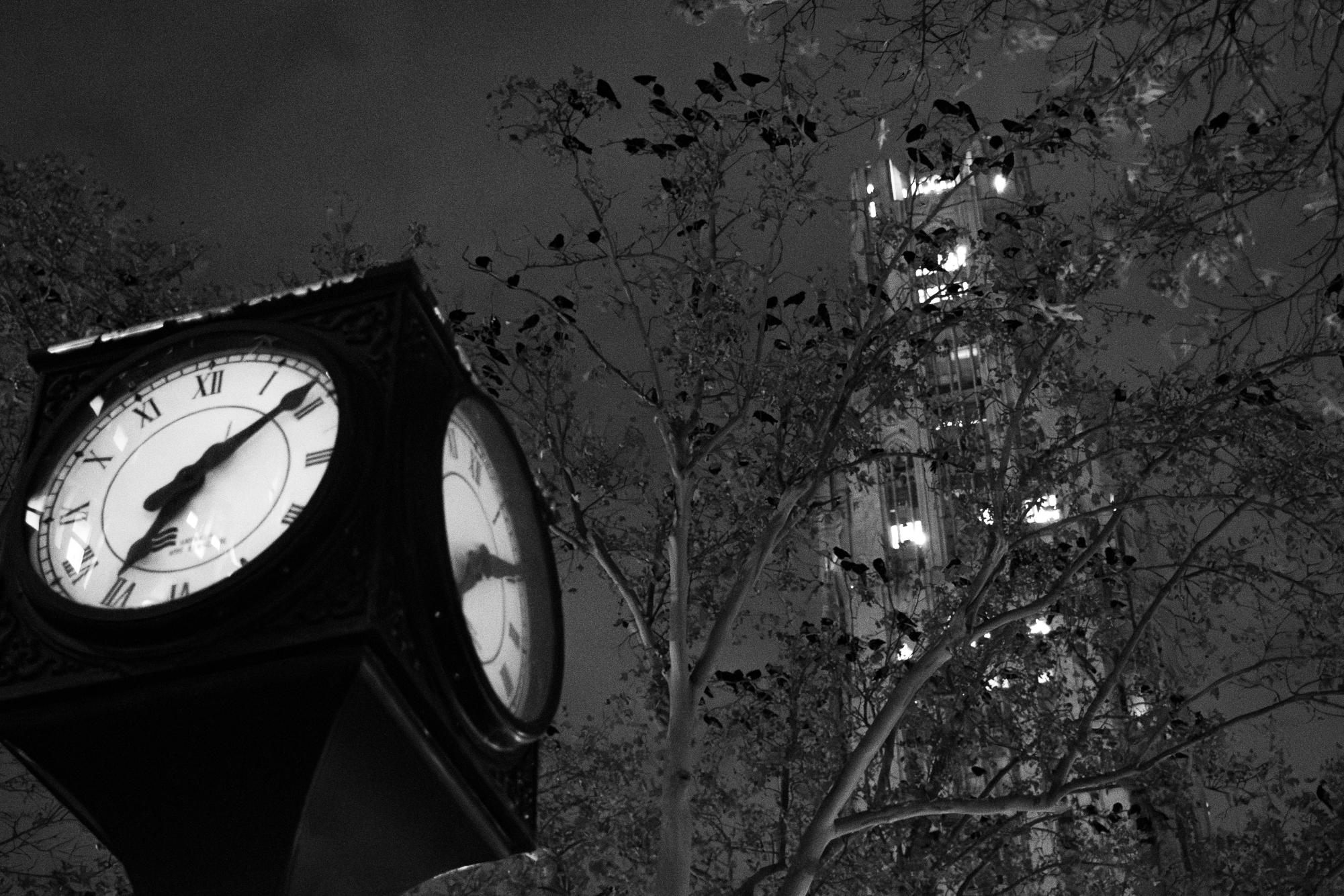Pitt sounds airhorns as crows migrate to campus


Crows perch on a tree outside the WPU.
As winter approaches and crows migrate to Pittsburgh in large masses, Pitt finds itself amidst a storm of crows and their droppings.
“The facilities grounds team added air horn use in response to increased crow volume and activity near Cathedral of Learning and William Pitt Union areas,” Dan Fisher, assistant vice chancellor of operations and maintenance for Facilities Management, said.
“This migration of crows happens a lot in urban areas,” Rory Carroll, teaching assistant professor of biology at Pitt, said. “Cities provide warmth, they provide food, they provide light. In an area like the Cathedral lawn, it’s really just in a lot of different ways a great habitat for roosting.”
Carroll explained how Pitt’s increasing crow population may be caused by crows migrating from Canada.
“There might be crows from more Northern areas migrating down to get here, and fewer crows that are leaving in the summer because our winters have been relatively mild,” Carroll said.
Crow droppings lined the sidewalks during the last couple of weeks, bringing attention from students to this corvid invasion.
Helen Hickey, a sophomore environmental engineering major, has had some negative experiences with the crows.
“I was walking to the Eatery in the evening … and one of them pooped on my shoulder,” Helen said. “In another encounter, I was walking home with my friends, and I felt it again.”
The Grounds Department provides various supplies, the most recent addition being the airhorn from this year, to combine methods that can be used to scare the crows off.
“They go to the bathroom on the sidewalks, which makes a mess … we actually use a scrubber and a pressure washer to clean it off,” Paul, one of the 31 grounds crew employees scaring the crows, said. “The mess is what we’re trying to prevent as we come through.”
The University has used many methods in the past, such as playing recordings of predator calls and clapping two dustpans together to create a loud sound, in an attempt to scare the crows off. This year, the Grounds Department uses airhorns and flashlights to scare the crows off.
“As crows become familiar with sounds over time, this treatment was added to a combination of recordings and clappers to deter them from roosting, with temporary horn sounds typically taking place from 5-7 a.m. and 5-10 p.m. during the fall and winter season,” Fisher said.
Carroll highlighted how the crows’ intelligence and their ability to learn patterns quickly allow them to adapt to many situations.
“If you’re just putting an air horn out there every night, maybe it scares them for a little bit, for the first couple of nights. After a while, they realize they aren’t in any danger, and it’s not going to be effective anymore,” Carroll said. “Research out there suggests that if you really want to be effective, you kind of have to vary the methods you’re using to discourage roosting.”
The workers make rounds around both lower and upper campus scaring the crows off. The timing of these methods changes through the season, stopping crows from settling into a routine.
“They run the shift twice. They run in the morning and in the evening just twice a day. It changes when sunup and sundown are,” Paul said. “It’s mostly to be scaring them after it gets dark, ‘cause that’s when they tend to settle in.”
Carroll mentioned that there may be some benefits to the presence of crows on the campus, such as their capacity as omnivores to consume mice, insects and even trash.
“The main concern is the excrement. It’s unsightly, and there are some concerns that it could be spreading bacteria. But it’s a pretty mild risk,” Carroll said.
Fisher further emphasized the risks crow waste poses for both students and Pitt infrastructure.
“These methods help to disperse them from populated areas while reducing slipping hazards, especially on sidewalks in wet weather due to increased crow waste that can accumulate, as well as reduce building damage over time,” Fisher said.
This problem of the crows’ roosting in Pittsburgh and the dilemma of how to get rid of them has been a persistent issue that Pitt has faced for several years. Despite the university’s efforts, Hickey said she feels the airhorn system doesn’t have much impact.
“I’ve heard them use the horns and then they all fly away, but I feel like there’s still a lot of them,” Helen said. “I’m not exactly sure what, but there has to be some other method besides the airhorn to lure them away from campus.”
Karleigh Sage, a freshman law, criminal justice and society major, who has also had an encounter with the crows and has strong feelings against them, doesn’t believe there’s much that the university can do.
“I was going out with my friend, and we were walking down Fifth Avenue across from Towers, and we felt something hit both of us … It was bird poop,” Sage said. “I’m still seeing the crows everywhere … You can’t really get rid of nature.”
Recent Posts
SGB addresses concerns about ICE presence on campus, hears SJP lawsuit against administration, approves governing code bill
At its weekly meeting on Tuesday at Nordy’s Place, Student Government Board heard concerns about…
ACLU of Pennsylvania sues Pitt over SJP suspension
The ACLU of Pennsylvania filed a federal civil lawsuit against the University of Pittsburgh and…
Marquan Pope: The ultimate shark
One of the most remarkable things about sharks is that an injury doesn’t deter them.…
Who Asked? // Do we really get a summer vacation?
This installment of Who Asked? by staff writer Brynn Murawski mourns the seemingly impossible perfect…
Notes From an Average Girl // Notes from my junior year
In this edition of Notes From an Average Girl, senior staff writer Madeline Milchman reflects…
Meaning at the Movies // The Power of the Movie Theater
In this edition of “Meaning at the Movies,” staff writer Lauren Deaton discusses her love…

